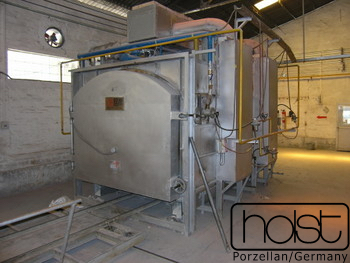Single firing
The definition of the single firing describes a firing technique used in the ceramics industry to compress porcelain - or the ceramic mass - from a shaping green body into a finished product by thermal fusion and vitrification of the raw materials (only in the case of porcelain).
Monofiring, also referred to as single-firing, is a common firing method of porcelain and ceramic tableware according to the current state of the art. The invention of monofiring goes hand in hand with the invention of porcelain and dates back to ancient times. The oldest monofiring kiln in the world - the Dragon Sanding Block - dating from 1582 can still be seen today in Foshan in southern China. This makes monofiring the oldest and most widespread firing technique for the production of porcelain and ceramic tableware.
The mono-firing is mostly used in Asia. If a manufacturer masters the monofiring process, then the state of glaze condition is the so-called green body. Mono firing eliminates the need for upstream cookie firing and can therefore be classified as more energy-saving and rational. In view of ever increasing energy and fuel costs, this means considerable cost savings in production. In addition, the saving of a complete firing process protects resources and the environment.
Monofiring can be carried out in tunnel kilns as well as in block kilns (chamber kilns) and is suitable for all types of ceramic tableware. Today, gas is predominantly used worldwide as the energy or fuel.
General advantages of single firing
First of all, the monofiring takes up considerably less space and room in a production area than a double firing. It is a complete kiln system with one less complete start-up and shut-down. The investment costs are extremely lower, because double filter and exhaust air systems, control systems up to necessary measures for occupational safety are not necessary.
Mono-firing consumes less energy and less fuel. Kiln cars, insulators, radiant heaters, gaskets, and even the fireclay plates, firing aids, and firebricks do not last forever. In other words, the overall maintenance of the porcelain firing is considerably cheaper than in the dual-firing process.
In monofiring, there is no need for double stacking and unstacking of tableware. This saves labor in traditional porcelain production, or robots and computer technology in the highly industrialized industry.
In sum and summary, monofiring is more economical, more ecological and considerably more sustainable than dual firing and, by saving resources, uncompromisingly better in terms of environmental protection!
General disadvantage of single firing
The degree of deformation of ceramic tableware - unfortunately, especially that of porcelain - is considerably higher than in dual firing due to shrinkage. Although double-fired porcelain is also not 100% equal and free of tolerances, but in total it is superior to the mono-fired tableware.
Mehr Nachteile erschließen sich uns nicht!
5 : 1 for single firing
The consumer ultimately decides which tableware items are acceptable for small tolerances and which are not, based on his or her demands and expectations of the product. A finger food bowl, an espresso cup or a corn-on-the-cob platter can certainly tolerate more tolerances than a gastronomic container or a system tableware.
The 5 advantages stated above indisputably outweigh the advantages of dual firing. In technical discussions, we repeatedly simper with the staff of the "Team Double Firing" about the durability of the firing emitters, insufficient degassing of the body, lower degree of vitrification and other technical details. However, all of these objections stem exclusively from the manufacturing doctrine of the European porcelain industry, which, according to Böttger (1708) and the National Museum in Hanoi (3,000 BC), lacks only about 3,000 years of experience in the application of monofiring technology.

